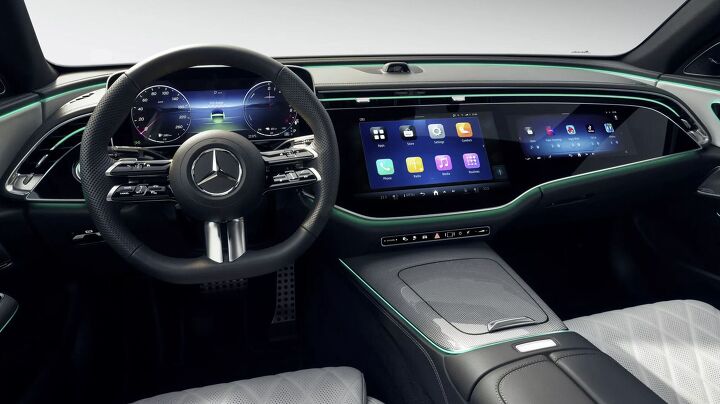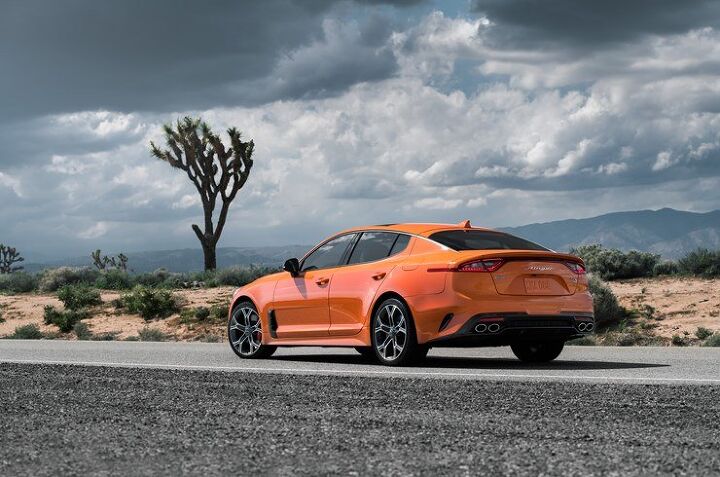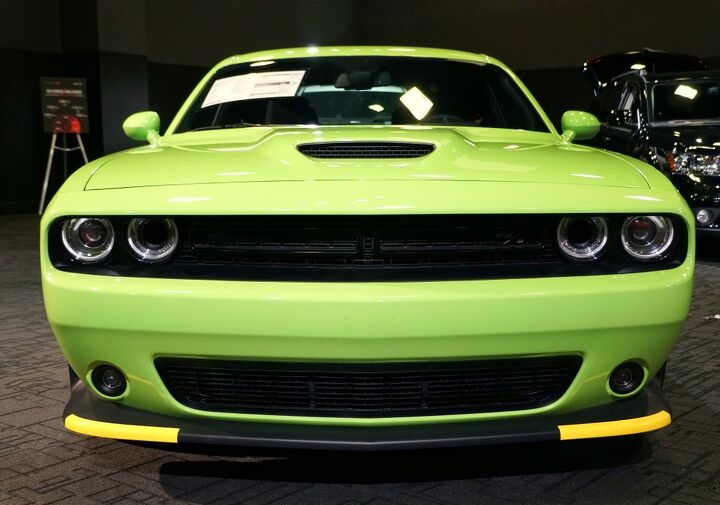#AutomotiveTrends
Driving Dystopia: Europe’s Low Emission Zones Aren't Going Over Well
With New York City having decided to embrace European-style congestion charging as local residents express their displeasure, it might be wise to take time to look at other roadway initiatives that might soon migrate across the Atlantic to see how they’re fairing. Ultra Low Emission Zones (ULEZ) seem to be the next step, as they’re reliant on the same camera systems and vehicle tracking used for congestion taxes. However, they’re also following a similar trajectory as Britain's speed cameras in Europe. Disgruntled citizens have not only continued destroying the devices, they’re reportedly picking up the pace.
Opinion: People Are Waking up to the Perils of Modern Automotive Features
One of the most infuriating things about this job is watching the media scratch its head about why roadway fatalities keep going up when the answer is as plain as the touchscreens on their dashboards. Modern vehicle interfaces are much more cumbersome than their predecessors and yet we’ve seen years' worth of coverage offering all the insight or a shrug. While there are certainly other reasons crashes have spiked (e.g. drug and alcohol abuse), the alluring tablet located next to your steering wheel has been the elephant in the room nobody was talking about — not with the seriousness that is deserved.
But things could be changing.
Automotive Study Confirms What You Already Know About Buttons VS Touchscreens
If you've ever piloted a modern vehicle, you've likely noticed that touchscreens have started supplanting physical controls. You've also probably found that they're not as easy to interface with as the buttons, switches, and knobs they're replacing. Well, there's another study out that's supporting what drivers have known for years – touchscreens don't make for intuitive vehicle controls and may even make the whole process of getting to your destination a little more treacherous.
Report: Some Automakers Abandoning AM Radio
An acquaintance of mine recently said he would never purchase an all-electric vehicle and offered up a reason I never heard before. “They don’t come with AM radio,” he said.
While this surprised me, shifting technological preferences have indeed started to change how automobiles and broadcasters interact. As an example, a gaggle of Mazda owners found their vehicles stuck tuned to National Public Radio this February after a local station transmitted an FM data packet that effectively froze the cars’ infotainment system amid the swap to next-generation broadband services. That transition has already caused some interesting problems for the industry and electromagnetic interference has likewise become the default explanation for automakers limiting your frequency band choice in certain vehicles. But it doesn’t explain why some companies are ditching AM radio outright. In fact, a little research has shown a lot of the explanations given by manufacturers leave a lot to be desired.
How Shanghai Lockdowns Are Changing the Auto Industry
While the semiconductor shortage was long considered the excuse par excellence for why the automotive sector couldn’t produce enough vehicles during the pandemic, some manufacturers have begun pivoting to blaming supply chains that have been stymied by Chinese lockdowns. Toyota is probably the best-known example. But the matter is hardly limited to a singular automaker and market analysts have already been sounding the alarm bell that strict COVID-19 restrictions in Asia will effectively guarantee prolonged industrial hardship around the globe.
Back in April, Shenzhen was emerging from a month-long lockdown. However, the resulting downtime severely diminished the tech hub’s output which exacerbated global component shortages. While Chinese state-run media claimed regional factories maintained full-scale production during the period, the reality was quite a bit different. Meanwhile, Shanghai has remained under harsh restrictions since March and more look to be on the horizon. As an important industrial center and the world’s busiest port by far, the situation has created an intense backlog of container ships that are presumed to create some of the sustained problems that we’re about to explore.
Dealers Annoyed With Price of EV Charger Installs
As the industry continues struggling with its planned swap to electric vehicles, we’ve seen plenty of framing suggesting dealer networks are only too happy to participate. But it’s usually juxtaposed with articles indicating that pushback exists, typically whenever the metaphorical rubber meets the road. This month provided several premium examples stemming from the National Automobile Dealers Association Expo (NADA Show 2022) held at the Las Vegas Convention Center.
Though the best had to be when several dealer groups piped up about how much it’s actually going to cost them to install some of the newer chargers some manufacturers believe should be mandatory if they’re intent on selling EVs. Some showrooms are finding out that not all buildings are wired for the high loads incurred by modern charging systems, requiring additional financial investments they hadn’t counted on. With automotive dealerships using product delays as leverage for unprecedented vehicle pricing, it’s nice to see them getting a taste of their own medicine. Or it would be if the costs for updating facilities weren’t guaranteed to be reflected on future window stickers.
Can Automakers Really Cash In on Connectivity and Subscription Schemes?
A little over a decade ago, it seemed like everyone I knew was abandoning cable packages for online streaming services. They were cheaper, on-demand, and offered more choices with fewer advertisements. But as the years progressed, companies stopped selling their media to a handful of online video platforms and started building their own. Programming became more transient and isolated, forcing consumers to buy into additional subscription services. We’ve since hit a point where the overall consumer experience has diminished and grown more expensive, despite the steady influx of competition.
While automakers have been dabbling with subscription services of their own, their earliest attempts turned out to be such overwhelmingly bad deals that the public refused to play along. But they’re not giving up that easily. Industry players have been trying to figure out ways to charge customers indefinitely for years and are starting to settle upon subscription packages that can unlock hardware that’s already been installed into the vehicle or add software that can be downloaded via over-the-air (OTA) updates. Love or hate it, vehicular connectivity has opened up the door for new sources of revenue and businesses everywhere are eager to take advantage — with most companies projecting exceptionally healthy profits for the years ahead.
Report: Apple Wants IPhone to Have More Control Over Cars
Most of us have synced our phones to a vehicle to play music, unwittingly funneling personal information to the manufacturer in the process. But only an elite few have used their mobile device to digitally summon an automobile out of a garage or remotely tell it to pre-condition interior temperatures to the desired specification. However, that’s likely going to be the future and Apple would very much like to be leading the charge.
The tech giant is reportedly developing a way to better integrate smartphones with cars by accessing systems that are currently unavailable to CarPlay. Apple’s new program, internally known as IronHeart, seeks to collaborate with automakers so that its phones can network with vehicles in new and interesting ways. It’s effectively CarPlay 2.0 and sounds as though it would be giving the company access to just about every item drivers might interface with on a daily basis.
Another One: FedEx Vows to Become Carbon Neutral by 2040
FedEx had kneeled before mankind, vowing to become a carbon-neutral business by 2040. That’s roughly eight years longer than it’ll probably take most of the population to forget that the promise was ever made. But this is the way of the world and we wager it won’t be long before it’s just easier to list the companies and governments that have not made informal, often empty commitments about the environment.
But, before we throw FedEx into the camp of blatant placation, let’s see what it actually has planned.
IRS Rolls Back Standard Mileage Rates for 2021
The IRS has issued the 2021 standard mileage rates used to calculate the deductible costs of operating an automobile for business, charitable, medical, or moving purposes.
Kia Says It's Still Betting On Sedans
While Kia has managed to add a fair number of crossovers to its lineup, successfully catching up to modern consumer tastes, it hasn’t scarified sedans to make that happen. According to the manufacturer, this is because high-riding utility vehicles fail to match the driving experience of a ground-hugging sedan — something Korean automakers have a keen interest in since Hyundai launched N-badged performance models and Kia dropped the Stinger on our heads.
Once famous for their commitment to budget-friendly models frequently mentioned in amber alerts, the duo now manufacture vehicles people actually want to buy at a price that’s frequently difficult to criticize. Following Hyundai/Kia for the last few years has been analogous to that scene in every teen drama where the awkwardly nerdy girl comes down the stairs for prom dressed to the nines and brimming with newfound confidence. Except in the Hyundai/Kia version, she winks suggestively and offers to pitch in for dinner.
Having convinced themselves that they’ve found a winning strategy, Koran automakers are doubling down on what’s worked already. That includes maintaining a clear distinction between crossovers and sedans — the latter of which Kia believes holds the secret to enjoying yourself behind the wheel.
Honda Snubs Touchscreen Controls: Good Idea, or Great Idea?
As the status of the North American Honda Fit remains unknown, its more evolved global sibling (the Jazz) hasn’t held our interest. With sales of economy vehicles still losing ground to crossovers and U.S. Fit volume going from modest to borderline meager over the last five years, there’s a good chance Honda may not bother updating it here.
The 2020 Euro-market reboot only offers a hybrid drivetrain — a 1.5-liter Atkinson-cycle engine mated to a 96-kW synchronous AC motor — and adds a plethora of standard safety tech and connectivity features. While other markets will see internal-combustion version, the best Honda has on offer is a pint-sized i-VTEC (988 cc) making 120 horsepower. Frankly, it doesn’t seem like a good fit for this market and may explain the company’s reluctance to confirm anything for North America. But Honda has made some changes that we hope carry over to all of its future products, regardless of the name carried on the rear hatch or the engine lurking beneath the hood.
Nissan Flees Fleet Reliance With 2020 Sentra
While fleet participation helped Nissan boost its sales volume for years, management feels it hasn’t done the company any favors in terms of profitability. As such, the company says it wants to take the 2020 Sentra out of the rental circuit. If you borrow a vehicle from rental agencies more than never, you’ve probably noticed Nissan’s compact sedan is often the default choice when the supply of Chevrolet Sonics or Toyota Corollas dries up.
Expect less of this moving forward, but be warned it’s not the dream scenario you envisioned. First off, there will undoubtedly be leftover 2019 models on rental lots for some time. Secondly, Nissan improved the 2020 Sentra to a point where you might actually prefer it. The manufacturer made no small effort effort to shore up the sedan’s ride quality, handling, comfort, tech and visual aesthetics for the new generation — succeeding rather well, according to our own Tim Healey. It also has a new 2.0-liter motor offering superior vigor versus its anemic 1.8-liter predecessor. With more on offer, Nissan figured it was a better idea to try it out on customers first, rather than assuming its rightful place is in a rental fleet.
Fade to Pink: Dodge Changes Splitter Guard Color
The yellow front splitter guards on Dodge’s Charger and Challenger have become a major point of conflict among automotive enthusiasts. In one corner, we have traditionalists who believe protective coverings used for shipping have no business appearing on a road-going car. In the other? A bunch of maniacs who think keeping the guards on adds something to the aesthetics, sort of like how you see people maintaining the stickers and tags on a new baseball cap.
Your author has seen a Challenger where the protectors had been on so long, they became sun-bleached and had started to lose their color. Dodge/SRT design boss Mark Trostle expressed his distaste for the trend in October, saying the guards were never part of the concept drawings and basically just ruin the paint.
Despite the issue causing a ruckus online, including some top-shelf trolling, some people still refuse to take them off. Dodge appears to have a plan, however. It’s swapping the protective coverings’ coloring from yellow to hot pink, presumably in an effort to discourage the trend.
Reasons Behind Cadillac Emblem 'Controversy' Finally Explained
Cadillac’s recent decision to move its corporate emblem to the top of the grille was, apparently, a very controversial one. While older models carried the badge dead center, current models have allowed the symbol to creep nearer to the hood latch. We failed to notice any riots in the streets over the change, but Cadillac Society contends there are a contingent of customers who don’t appreciate the new look.
It also has the answers for why General Motors thought the modification necessary.






























Recent Comments